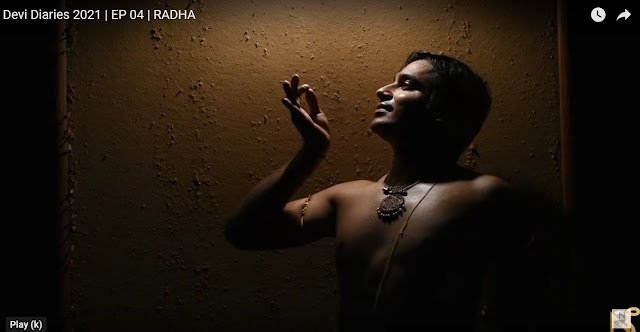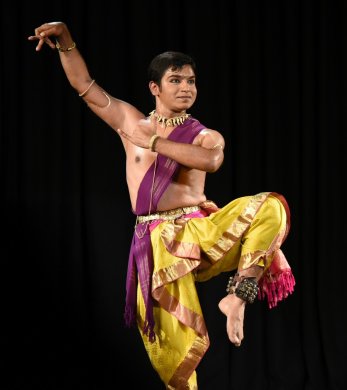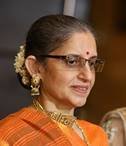
|
 |

|
 |
Himanshu Shrivastava: As a dancer I am an explorer, a seeker - Shveta Arora e-mail: arorashveta1806@gmail.com June 14, 2022 Himanshu Shrivastava is a young Bharatanatyam dancer whom I have been watching with increasing respect and admiration over the years. He is a disciple of gurus Saroja Vaidyanathan, Rama Vaidyanathan and Kamalini Dutt. He is also a Sanskrit scholar and an established painter and artist. His own choreographies, like 'Shikhandi', have been thought provoking as well as technically mature and masterfully danced. During the pandemic, I have seen two short videos of his - 'Radhika' (for Anita Ratnam's Devi Diaries) and 'Baazi' - which surprised me with their made-for-camera ethos and their camera work, locations etc, standing out for their conceptual depth, visual richness and technical skill in just a few minutes, even in an overcrowded online dance video space. I thus spoke to Himanshu about being a dancer 'online' during these two years of Covid-19 lockdowns and restrictions. Choreographing for stage and then adapting to video vs. choreographing innately for the camera... In the pandemic, everything is new for everyone, of course. But somewhere, I could sense that now the breadth of my audience has contracted to one little hole in the camera lens-not a huge auditorium but one pinpoint. In dance, especially nritta, and especially the adavus, are always audience-centric. We make sure the profile is right from each side-a dancer has to be very careful about profile projection and the visibility of that makes a lot of difference. Thrown in this situation suddenly, I immediately understood that now I have to choreograph according to the camera. And here the only privilege, I felt, was-and it took me a little time to get this, obviously-I realized the camera can also act as the amphitheatre by going around you. So we need to discover this new technology, the lens of the new audience, in a different way. Initially, I started with a fixed camera and later started moving it. Obviously, I ruminated upon how a movie is made, the intricacies of movie making in the context of how to do choreography. Things could also be split into parts. We were less about showing stamina, more about projecting beauty, youth, handsomeness, any beautiful aspect or point. We were otherwise producers but also became directors. We were sitting and preparing all those individual frames that we wanted. Now, the idea of the stage was moving towards the conception of a frame-how we set a piece frame by frame. I would say that when choreographing for the camera, I totally think about the audience and the medium, and I think that is the smart way to do it. If something is being projected on screen, it's 2D, and you are supposed to work on your audience in that way, in that particular medium. You must compose each frame very carefully. Unlike the regular spectator setting in an auditorium, on camera we can produce varied effects and use other things, somewhat like a movie, all the while sticking to our roots. Different angles can create different effects. So that is what I feel I discovered-it was kind of a lesson for me to look again at our evolving audience in a very different frame. My perspective is, think of the medium that is going to project that performance. The choreography will automatically follow. Audience attention spans on camera... The capacity of the audience to hold a frame in their minds is limited - it is commonly seen that they don't retain it for a very long time. Hence, every frame needs to be very well thought of so it stays in the audience's minds. The biggest challenge - for not only me but for any dancer - was that there was a huge pooling in of videos; every artiste was making one. What was happening was that the audience was getting a bit bored. Each time you are working on a classical dance presentation, you really need to work right from scratch, build it up in a fashion that really hits the eye and attention of the audience. That really makes a difference. We call Indian cinema Bollywood, south cinema Kollywood, Tollywood and so on; I think we really need a name now for Bharatanatyam and classical Indian dance because it's no less than a production-direction team. The effort and bother required has increased fourfold, but it's been good learning. Makeup, costuming and location...  When I was shooting for 'Radhika' (for Narthaki's Devi Diaries), the biggest challenge was to think from scratch. One is supposed to present a goddess, a gopika - I'm being daring in calling her that, she was so much beyond that, possibly a concept - all of that in that one little video. The first thing that came to my mind was that I had to get into a surreal space. For that, I would either have had to use VFX - and I would go to that extent if needed - or get a location that did that job, but the location worked out. I had to do a recce of Zorba (an events venue in Delhi). It really had all of what I wanted. Radhika dancing alone in the raasmandal is a connotation, a metaphor for a lot of things, other phenomena. In that anand mandala, she is Krishna and Radha equally. One by one, I started discovering spots in the venue. There are two methods - either you be dependent on the frame you want, or you look around, get the feel of the frames available, which you can create, and then build upon that. These are the only two ways that one has. For Radhika, I used the first one. I had a few things in my mind, that this and this should work, and then I did the recce and thought the space was good enough to say what I was trying to say. There was a switch between Radha and Krishna and Krishna and Radha. So I think the ambience played a nice role, and the pathway where she is walking towards the raasmandala... it was a better way of working on the nritta and the abhinaya.  In contrast, 'Baazi' (a Valentine's Day presentation for Aalaap Concepts) was a monologue where I had to do that talk all alone between Radha and Krishna. I could have switched screens also. But I felt that the strength of Indian classical dance, where we don't always have to change the frame, is what I thought I should project. Also, it was going with the schema that they say there was a Shiva temple where these two met for the first time. I thought, let's take them inside the temple, that will add to the beauty of the ambience, and there the dice game would happen between Radha and Krishna. Instead of changing frames and using close-ups and all - Baazi was very short, and Radhika was a bit longer - I thought let's not move the camera too much. I thought, let's just place the camera, and use the biggest strength of Indian classical dance, where the dancer switches bodies and genders. So that is what you see in that short video in which I have tried to be Krishna and Radha at the same time. And also Kamadeva, who breaks his sugarcane bow and divides it equally between the two - you two take care of love, I am giving up. Is abhinaya better on video? I think that totally depends upon the frames you are taking. If the dancer is intelligent, she will know it is a very critical moment where just a look of the eye is conveying all of that - I think a closeup will do the needful. Though it is challenging, I still feel, as much as the audience is evolving with time -and it has evolved over the pandemic - the dancers have also evolved their thought process. When there is a fixed stage and the audience is sitting around us, we work on the diagonals. Our diagonals, our lines change with each stage. With video, everything is reduced to a small focal point. Obviously, it will make a lot of difference. I feel we are all still at the level where we are discovering our lines in accordance with the camera. One has to relook how we are working on that in each production - is the camera moving or me, is it in or out etc. How we are conceiving it depends on that. If -touch wood, I hope not - it continues like this (with restrictions on public spaces and meetings), we dancers will really need to have another team of experts - strong visual experts, VFX people or camera people who know the angles of what we are doing. Nritta is all about creating, especially in Bharatanatyam, geometric lines. And those lines work on the psyche of the audience. When we repeat the geometry, it stays in their minds. That is not possible on video because the capacity to hold on a screen is limited - the time span is very short. In that span, we cannot be doing a left and a right n number of times. We need to restrict, relook, rework. I'm still discovering every day. I definitely enjoyed working with the camera. It was the first time I was put into such conditions. Many things are yet to be discovered and I'm still working on it. I hope things will go well. Giving directions to videographers...  (Photo: Anoop Arora) Apart from the discussion that we dancers have with videographers, the example I have is quite funny. My brother is the one who has been working on all my videos. He is a professional in video, but he's never done it for dance. He works on videography, special effects, VFX and has worked with great directors. But when it came to Indian classical dance, he was sitting in one corner like a duck. In one video, I was dancing in a temple kund. I asked him to gauge the vibes of the piece; I told him, I cannot all the time sit and explain it to you. You need to discover it. You already know Sanskrit, so it isn't much of a problem - it was a family thing so he also knows it. So I asked him, if you need to move, move with your gimbal. But he just perched in one corner and was taking the video continuously and I'm jumping around, hopping around the whole temple. I turned around, saw him and yelled, 'Why aren't you moving?' And it looked like he just woke up from his dream; he said, 'Oh, was I supposed to move?' And I replied, 'What have I been saying about vibes?' Like the way we work with our vocalists and musicians, we must work with the videographers - we cannot simply leave it to them. We need to have sessions with them, sit with them and explain the choreography, the intensity, let them learn the classical dancer's body, how it behaves in a particular light. It was a beautiful frame, I remember - within the temple ruins there was a lovely small pond. And stairs were going up and then an alley and suddenly the view opened up to the sky. After almost six hours of scolding, a light bulb went on in my brother's head and he said, 'Dada, why don't you go there, do some moves, make sure you do a slow move...' Do you see the conversation? A director was sitting there, writing the whole dance choreography and I said, 'Are you asking me to change the choreography?' He said, 'No, try something.' So another thing is that the dancer needs to be very flexible. The venues can demand anything and everything. The light intensity changes. Of course, we can go on another day also, but if you are on a very tight budget, you need to work with whatever is available. You need to be smart enough to change the choreography on the spot and make it fit your thought process. We were hopping like monkeys everywhere with my poor brother getting all the scolding, a whole year's worth. It was a real discovery - had it been anybody else, we would have been in equal peril: what are we really wanting? But then he discovered it, how to deal with the body. But it takes a conversation; as much as we have a conversation with our own dance adavus, we need to have a good conversation and rapport with the videographer. We can come up with some good frames this way. Adapting to hybrid performances... As a dancer, I am an explorer, a seeker. We could have seen even worse times; we could have been locked up for years, possibly. But we were blessed to have this beautiful, short experience of this lockdown and of learning from it. I think I've learnt from it and I have gained. So I won't say I'm uncomfortable with it. I would say that as dancers, we should learn from this new medium because it has a lot of scope. We are now moving - how should I put it? - towards the cinema industry. A section of classical dancers have now branched off towards that direction. And the people who have learnt out of it will come up with some brilliant ideas in mixed media. And I think mixed media have always been in vogue; so many productions have used them. We have all these PPT presentations going along with dance, both seniors and youngsters have done it. So why not embrace it with grace? With time, we'll know where to gauge it, where to use it or not. I think I'm in favour of it, but only if you have a good dialogue with the medium. Getting through Covid lockdowns... When the lockdowns began and we were told in the sixth month that this would continue for a while, I dare say every single dancer would have wondered 'how will it be?' We were so used to visiting stage but here, there was no audience, nothing. But there was a little streak of hope. I'll be frank - there was a time when we would all mock people dancing inside a room and putting it up online, as much as wearing a mask was mocked in India. In a similar fashion, we used to laugh at those 'in-house' performances earlier - perhaps not laugh exactly, but we certainly wondered why. All of a sudden, we all became the same. We really felt, now is the time we need to accept all of this. My painting didn't suffer much, though - to be honest, I got a lot of painting opportunities and ideas and contracts, some big ones, because as you know, there was a rise in purchases of houses, cars etc. during the lockdown. It was possibly a consequence of that - since people had new spaces and they wanted something new, I probably got opportunities to paint, so I really worked a lot on paintings at that time. Dance was also happening. The best was that I got an opportunity to sit with my mentor in online sessions during that time and talk about all those things which I could not discuss earlier because of the rush of performances - you know how daily life for a dancer is. Somewhere, you miss that one conversation with your teacher. And here we had all the time. Those were the few moments that I will really cherish. That said, I do not support any more lockdowns! Those moments are enough, I don't want them anymore! Those born in these three years will never know what we, especially art, have gone through. There were sad parts where I myself saw junior colleagues and even senior artistes living at the edge of their means. And with no audience, no supporters, how would an artiste live? But then, a few got strength and a few lost the battle. And here we are and we are reopening and hoping that no more battles of this variety will resurface. Nothing should threaten the existence of artistes anymore. Art is strong but really needs the audience as a support, so let's hope for the best. Contact Himanshu Shrivastava: himanshuart2901@gmail.com  Shveta Arora is a dance-mad writer who chronicles classical dance events in Delhi (and also those online). In 2009, she started the blog Kala Upasana at delhiculturecomment.blogspot.com, where she began posting her own writing along with photographs clicked by Anoop Arora, her husband. She's been dancing all her life as a devotee, but resumed her formal training in Kathak in her 50s and has passed her fifth year Kathak exams. Post your comments Please provide your name and email id when you use the Anonymous / blog profiles to post a comment. All appropriate comments posted with name and email id in the blog will be featured in the site. |